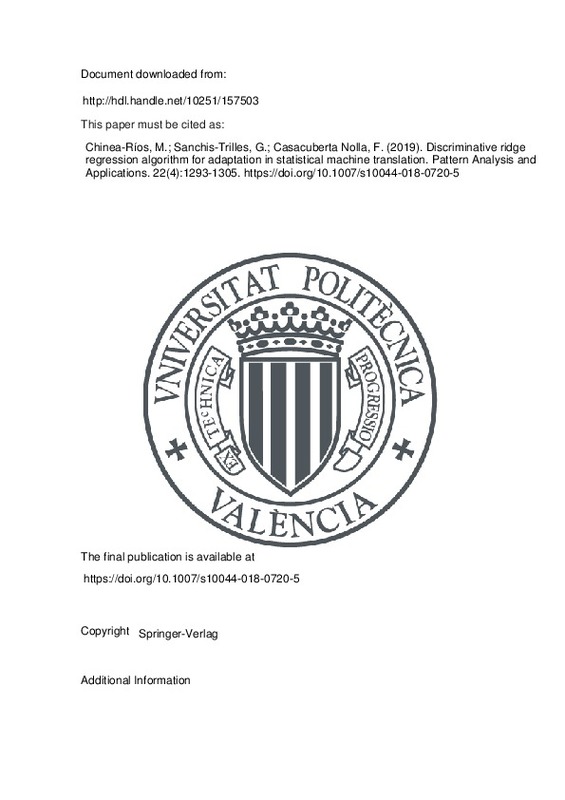Barrachina S, Bender O, Casacuberta F, Civera J, Cubel E, Khadivi S, Lagarda A, Ney H, Tomás J, Vidal E et al (2009) Statistical approaches to computer-assisted translation. Comput Ling 35(1):3–28
Bojar O, Buck C, Federmann C, Haddow B, Koehn P, Monz C, Post M, Specia L (eds) (2014) Proceedings of the ninth workshop on statistical machine translation. Association for Computational Linguistics
Brown PF, Pietra VJD, Pietra SAD, Mercer RL (1993) The mathematics of statistical machine translation: parameter estimation. Comput Ling 19:263–311
[+]
Barrachina S, Bender O, Casacuberta F, Civera J, Cubel E, Khadivi S, Lagarda A, Ney H, Tomás J, Vidal E et al (2009) Statistical approaches to computer-assisted translation. Comput Ling 35(1):3–28
Bojar O, Buck C, Federmann C, Haddow B, Koehn P, Monz C, Post M, Specia L (eds) (2014) Proceedings of the ninth workshop on statistical machine translation. Association for Computational Linguistics
Brown PF, Pietra VJD, Pietra SAD, Mercer RL (1993) The mathematics of statistical machine translation: parameter estimation. Comput Ling 19:263–311
Callison-Burch C, Koehn P, Monz C, Peterson K, Przybocki M, Zaidan OF (2010) Findings of the 2010 joint workshop on statistical machine translation and metrics for machine translation. In: Proceedings of the annual meeting of the association for computational linguistics, pp 17–53
Chen B, Cherry C (2014) A systematic comparison of smoothing techniques for sentence-level bleu. In: Proceedings of the workshop on statistical machine translation, pp 362–367
Cherry C, Foster G (2012) Batch tuning strategies for statistical machine translation. In: Proceedings of the North American chapter of the association for computational linguistics, pp 427–436
Clark JH, Dyer C, Lavie A, Smith NA (2011) Better hypothesis testing for statistical machine translation: controlling for optimizer instability. In: Proceedings of the annual meeting of the association for computational linguistics, pp 176–181
Crammer K, Dekel O, Keshet J, Shalev-Shwartz S, Singer Y (2006) Online passive-aggressive algorithms. J Mach Learn Res 7:551–585
Hasler E, Haddow B, Koehn P (2011) Margin infused relaxed algorithm for moses. Prague Bull Math Ling 96:69–78
Hopkins M, May J (2011) Tuning as ranking. In: Proceedings of the conference on empirical methods in natural language processing, pp 1352–1362
Kneser R, Ney H (1995) Improved backing-off for m-gram language modeling. In: Proceedings of the international conference on acoustics, speech and signal processing, pp 181–184
Koehn P (2005) Europarl: a parallel corpus for statistical machine translation. In: Proceedings of the machine translation summit, pp 79–86
Koehn P (2010) Statistical machine translation. Cambridge University Press, Cambridge
Koehn P, Hoang H, Birch A, Callison-Burch C, Federico M, Bertoldi N, Cowan B, Shen W, Moran C, Zens R, Dyer C, Bojar O, Constantin A, Herbst E (2007) Moses: open source toolkit for statistical machine translation. In: Proceedings of the annual meeting of the association for computational linguistics, pp 177–180
Lavie MDA (2014) Meteor universal: language specific translation evaluation for any target language. In: Proceedings of the annual meeting of the association for computational linguistics, pp 376–387
Marie B, Max A (2015) Multi-pass decoding with complex feature guidance for statistical machine translation. In: Proceedings of the annual meeting of the association for computational linguistics, pp 554–559
Martínez-Gómez P, Sanchis-Trilles G, Casacuberta F (2012) Online adaptation strategies for statistical machine translation in post-editing scenarios. Pattern Recogn 45(9):3193–3203
Nakov P, Vogel S (2017) Robust tuning datasets for statistical machine translation. arXiv:1710.00346
Neubig G, Watanabe T (2016) Optimization for statistical machine translation: a survey. Comput Ling 42(1):1–54
Och FJ (2003) Minimum error rate training in statistical machine translation. In: Proceedings of the annual meeting of the association for computational linguistics, pp 160–167
Och FJ, Ney H (2003) A systematic comparison of various statistical alignment models. Comput Ling 29:19–51
Papineni K, Roukos S, Ward T, Zhu WJ (2002) Bleu: a method for automatic evaluation of machine translation. In: Proceedings of the international conference on acoustics, speech and signal processing, pp 311–318
Sanchis-Trilles G, Casacuberta F (2010) Log-linear weight optimisation via Bayesian adaptation in statistical machine translation. In: Proceedings of the annual meeting of the association for computational linguistics, pp 1077–1085
Sanchis-Trilles G, Casacuberta F (2015) Improving translation quality stability using Bayesian predictive adaptation. Comput Speech Lang 34(1):1–17
Snover M, Dorr B, Schwartz R, Micciulla L, Makhoul J (2006) A study of translation edit rate with targeted human annotation. In: Proceedings of the annual meeting of the association for machine translation in the Americas, pp 223–231
Sokolov A, Yvon F (2011) Minimum error rate training semiring. In: Proceedings of the annual conference of the European association for machine translation, pp 241–248
Stauffer C, Grimson WEL (2000) Learning patterns of activity using real-time tracking. Pattern Anal Mach Intell 22(8):747–757
Stolcke A (2002) Srilm—an extensible language modeling toolkit. In: Proceedings of the international conference on spoken language processing, pp 901–904
Tiedemann J (2009) News from opus—a collection of multilingual parallel corpora with tools and interfaces. In: Proceedings of the recent advances in natural language processing, pp 237–248
Tiedemann J (2012) Parallel data, tools and interfaces in opus. In: Proceedings of the language resources and evaluation conference, pp 2214–2218
[-]







![[Cerrado]](/themes/UPV/images/candado.png)


